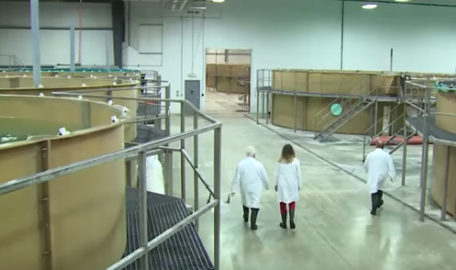Since 1991, Aquabounty has incurred net losses of approximately USD 126 million.
Land-based GM salmon farmer AquaBounty has announced its financial results for the second quarter and six months ended June 30, 2019.
The company said it has stocked its Indiana and Rollo Bay farm sites with AquAdvantage Salmon eggs to commence grow-out and proceed towards finally bringing the fast-growing fish to market.
Net loss for the six-month period ended June 30, 2019, increased to USD 6.8 million from USD 5.2 million in the corresponding period of the previous year, and net loss for the three-month period ended June 30, 2019, increased to USD 4.0 million from USD 2.8 million in the corresponding period of the previous year, due to “increases in headcount and associated ramp-up costs at the company’s grow-out farm in Indiana, stock compensation charges, and legal fees in support of the U.S. Food and Drug Administration’s (FDA) defense of their approval of AquAdvantage Salmon.”
AquaBounty Chief Executive Officer Sylvia Wulf stated: “This past quarter was a historic one for AquaBounty, as the FDA’s lifting of the Import Alert on AquAdvantage Salmon allowed us to stock our eggs at our Indiana farm site and, for the first time ever, grow our fish in the United States. We also stocked our new farm in Rollo Bay on Prince Edward Island and completed second equity fundraise to continue to improve our balance sheet.
“I am also pleased to welcome David Melbourne, Jr. to AquaBounty in his new role as Chief Commercial Officer and I would like to announce the appointment of Dr. Mark Walton to the position of Vice President of Research and Regulatory Affairs following the retirement of Dr. Ronald Stotish. With these changes, we continue to build and strengthen our senior management team as we move forward to execute our commercial plan.”
On its 10-Q Form, AquaBounty posted:
“We have a history of net losses and will likely incur future losses and may not achieve or maintain profitability. Although we were established in 1991, we did not start to develop our current product portfolio until 1996. In the period since incorporation to June 30, 2019, we have incurred net losses of approximately $126 million. These losses reflect our personnel, research and development, and marketing costs. We have constructed a 250-metric-ton annual capacity production facility in Rollo Bay, and in 2017 we acquired a facility in Albany, Indiana, which has undergone renovations to increase its annual capacity to 1,200 metric tons. We expect more significant revenues in 2020 once our new facilities are in full production. However, our ability to realize revenues and the timing thereof are not certain, and achieving revenues does not assure that we will become profitable.”

